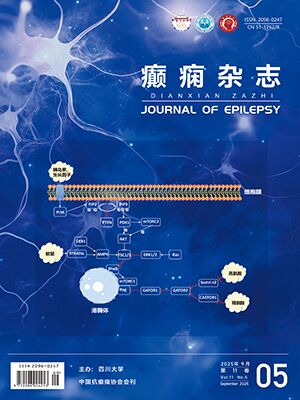| 1. |
Beghi E, Giussani G. Aging and the epidemiology of epilepsy. Neuroepidemiology, 2018: 216-223.
|
| 2. |
Wang W, Wu J, Dai X, et al. Global campaign against epilepsy: assessment of a demonstration project in rural China. Bull World Health Organ, 2008, 86(12): 964-969.
|
| 3. |
Dalic L, Cook MJ. Managing drug-resistant epilepsy: challenges and solutions. Neuropsychiatr Dis Treat, 2016, 12: 2605-2616.
|
| 4. |
Casciato S, Quarato PP, Gialluisi A, et al. Lacosamide as first add-on or conversion monotherapy: a retrospective real-life study. Epilepsy Behav, 2021, 122: 108-128.
|
| 5. |
Lattanzi S, Trinka E, Zaccara G, et al. Third-generation antiseizure medications for adjunctive treatment of focal-onset seizures in adults: a systematic review and network Meta-analysis. Drugs, 2022, 82(2): 199-218.
|
| 6. |
Abou-Khalil BW. Update on antiseizure medications 2022. Continuum (Minneap Minn), 2022, 28(2): 500-535.
|
| 7. |
Wilson SM, Khanna R. Specific binding of lacosamide to collapsin response mediator protein 2 (CRMP2) and direct impairment of its canonical function: implications for the therapeutic potential of lacosamide. Molecular Neurobiology, 2015, 51(2): 599-609.
|
| 8. |
Ruffolo G, Di Bonaventura C, Cifelli P, et al. A novel action of lacosamide on GABAA currents sets the ground for a synergic interaction with levetiracetam in treatment of epilepsy. Neurobiology of disease, 2018, 115: 59-68.
|
| 9. |
Corvace F, Faustmann TJ, Faustmann PM, et al. Anti-inflammatory properties of lacosamide in an astrocyte-microglia co-culture model of inflammation. Eur J Pharmacol, 2022, 915: 174696.
|
| 10. |
Vossler DG, Knake S, O’Brien TJ. Efficacy and safety of adjunctive lacosamide in the treatment of primary generalised tonic-clonic seizures: a double-blind, randomised, placebo-controlled trial. J Neurol Neurosurg Psychiatry, 2020, 91(10): 1067-1075.
|
| 11. |
Inoue Y, Liao W, Wang X, et al. Safety and efficacy of adjunctive lacosamide in Chinese and Japanese adults with epilepsy and focal seizures: a long-term, open-label extension of a randomized, controlled trial. Epilepsy Research, 2021, 176: 106705.
|
| 12. |
Alkhotani A, Abualula H, Almatrafi Y, et al. Efficacy and tolerability of lacosamide for focal epileptic patients: study from epilepsy clinic in Makkah. CNS Neurol Disord Drug Targets, 2021, 20(1): 87-97.
|
| 13. |
Pozzi M, Zanotta N, Epifanio R, et al. Lacosamide effectiveness and tolerability in patients with drug-resistant epilepsy and severe disability under polytherapy: therapy optimization as emerging from an observational study. Epilepsy Behav, 2022, 128: 108598.
|
| 14. |
d’Orsi G, Pascarella MG, Martino T, et al. Intravenous lacosamide in seizure emergencies: observations from a hospitalized in-patient adult population. Seizure, 2016, 42: 20-28.
|
| 15. |
Santamarina E, Toledo M, Sueiras M, et al. Usefulness of intravenous lacosamide in status epilepticus. Journal of Neurology, 2013, 260: 3122-3128.
|
| 16. |
Kellinghaus C, Berning S, Stogbauer F. Intravenous lacosamide or phenytoin for treatment of refractory status epilepticus. Acta Neurol Scand, 2014, 129: 294-299.
|
| 17. |
Okanishi T, Fujii Y, Sakuma S, et al. Lacosamide monotherapy for the treatment of childhood epilepsy with centrotemporal spikes. Brain Dev, 2022, 44(6): 380-385.
|
| 18. |
Yildiz EP, Ozkan MU, Bektas G, et al. Lacosamide treatment of childhood refractory focal epilepsy: thefirst reported side effect in paediatric patients. Child's Nervous System, 2017, 33(11): 2023-2027.
|
| 19. |
Grosso S, Zamponi N, Bartocci A, et al. Lacosamide in children with refractory status epilepticus: a multicenter Italian experience. Eur J Paediatr Neurol, 2014, 18: 604-608.
|
| 20. |
Arkilo D, Gustafson M, Ritter FJ. Clinical experience of intravenous lacosamide in infants and young children. Eur J Paediatr Neurol, 2016, 20: 212-217.
|
| 21. |
Poddar K, Sharma R, Ng YT. Intravenous lacosamide in pediatric status epilepticus: an open-label efficacy and safety study. Pediatr Neurol, 2016, 61: 83-86.
|
| 22. |
Miskin C, Khurana DS, Valencia I, et al. Efficacy and tolerability of lacosamide in the treatment of children with refractory generalized epilepsy. J Child Neurol, 2016, 31(7): 925-928.
|
| 23. |
Nevitt SJ, Sudell M, Cividini S, et al. Antiepileptic drug monotherapy for epilepsy: a network meta-analysis of individual participant data. Cochrane Database Syst Rev, 2022, 4(4): CD011412.
|
| 24. |
Park M, Kim SE, Lee BI. Antiepileptic drug therapy in patients with drug-resistant epilepsy. J Epilepsy Res, 2019, 9: 14-26.
|
| 25. |
Bosak M, Wężyk K, Słowik A. Lacosamide and myoclonic seizures: what is the risk of aggravation? Neurol Neurochir Pol, 2021, 55(1): 107-109.
|
| 26. |
Shin YW, Moon J, Cho YW, et al. Tolerability of lacosamide rapid dose titration: a randomized, multicenter, prospective, open-label study. Epilepsy & Behavior, 2021, 115: 107663.
|
| 27. |
Eilam A, Khmeliov N, Penker D, et al. Intravenous lacosamide in seizure clusters: dose and efficacy. Clinical Neuropharmacology, 2021, 44(3): 85-88.
|
| 28. |
Liparoti G, Burchiani B, Mencaroni E, et al. Individualizing doses of antiepileptic drugs. Expert Opin Drug Metab Toxicol, 2022, 18(3): 219-233.
|
| 29. |
Watkins LV, Kerr MP. Treatment of psychiatric comorbidities in patients with epilepsy and intellectual disabilities: is there a role for the neurologist? Epilepsy & Behavior, 2019, 98: 322–327.
|




